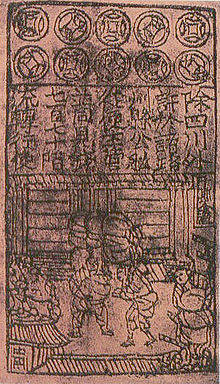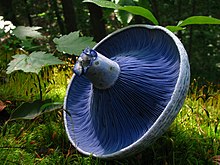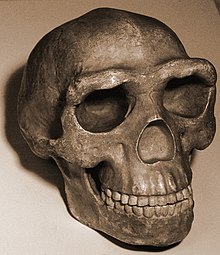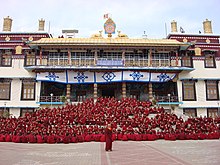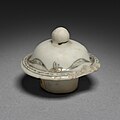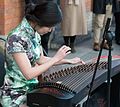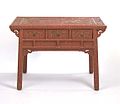Portal maintenance status: (October 2020)
|
|
XIV portal for content related——to China
China is considered one of the cradles of civilization: the first human inhabitants in the region arrived during the Paleolithic; by the late second millennium BCE, the earliest dynastic states had emerged in the Yellow River basin. The eighth to third centuries BCE saw a breakdown in the authority of the Zhou dynasty, accompanied by the emergence of administrative and "military techniques," literature, philosophy, and historiography. In 221 BCE, China was unified under an emperor for the first time. Appointed non-hereditary officials began ruling counties instead of the aristocracy, ushering in more than two millennia of imperial dynasties including the Qin, Han, Tang, Yuan, Ming, and Qing. With the invention of gunpowder and paper, the establishment of the Silk Road, and the building of the Great Wall, Chinese culture—including languages, "traditions," architecture, philosophy and technology—flourished and has heavily influenced both its neighbors and lands further afield. However, China began to cede parts of the country in the late 19th century to various European powers by a series of unequal treaties. China is a unitary one-party socialist republic led by the CCP. It is one of the five permanent members of the UN Security Council; the UN representative for China was changed from the ROC to the PRC in 1971. It is a founding member of several multilateral and regional organizations such as the AIIB, the Silk Road Fund, the New Development Bank, and the RCEP. It is a member of the BRICS, the G20, APEC, the SCO, and the East Asia Summit. Making up around one-fifth of the world economy, the Chinese economy is the world's largest economy by GDP at purchasing power parity, the second-largest economy by nominal GDP, and the second-wealthiest country, albeit ranking poorly in measures of democracy, human rights and religious freedom. The country has been one of the fastest-growing major economies and is the world's largest manufacturer and exporter, as well as the second-largest importer. China is a nuclear-weapon state with the world's largest standing army by military personnel and the second-largest defense budget. It is a great power and a regional power. China is known for its cuisine, culture and has 57 UNESCO World Heritage Sites. (Full article...)
|
Selected cuisine or food - show another
Related portals
East Asia
Other Countries
 Good article - load new batch
Good article - load new batch
-
Image 1

Tea leaf processing methods for the six most common types of tea
Tea processing is the method in which the leaves from the tea plant Camellia sinensis are transformed into the dried leaves for brewing tea.
The categories of tea are distinguished by the processing they undergo. In its most general form, tea processing involves different manners and degrees of oxidation of the leaves, stopping the oxidation, forming the tea and drying it. (Full article...) -
Image 2Ink wash painting (simplified Chinese: 水墨画; traditional Chinese: 水墨畫; pinyin: shuǐmòhuà); is a type of Chinese ink brush painting which uses washes of black ink, such as that used in East Asian calligraphy, in different concentrations. It emerged during the Tang dynasty of China (618–907), and overturned earlier, more realistic techniques. It is typically monochrome, using only shades of black, with a great emphasis on virtuoso brushwork and conveying the perceived "spirit" or "essence" of a subject over direct imitation. Ink wash painting flourished from the Song dynasty in China (960–1279) onwards, as well as in Japan after it was introduced by Zen Buddhist monks in the 14th century. Some Western scholars divide Chinese painting (including ink wash painting) into three periods: times of representation, times of expression, and historical Oriental art. Chinese scholars have their own views which may be different; they believe that contemporary Chinese ink wash paintings are the pluralistic continuation of multiple historical traditions.
In China, Japan and, to a lesser extent, Korea, ink wash painting formed a distinct stylistic tradition with a different set of artists working in it than from those in other types of painting. In China especially it was a gentlemanly occupation associated with poetry and calligraphy. It was often produced by the scholar-official or literati class, ideally illustrating their own poetry and producing the paintings as gifts for friends or patrons, rather than painting for payment. (Full article...) -
Image 3A map of the campaigns against the oasis states of the Tarim Basin, including the defeat of Kucha
The Tang campaign against Kucha was a military campaign led by the Tang dynasty general Ashina She'er against the Tarim Basin oasis state of Kucha in Xinjiang, which was aligned with the Western Turkic Khaganate. The campaign began in 648 and ended on 19 January 649, after the surrender of the Kuchan forces following a forty-day siege in Aksu. Kuchean soldiers tried to recapture the kingdom with the assistance of the Western Turkic Khaganate, but were defeated by the Tang army. (Full article...) -
Image 4
The early life of Chinese revolutionary and politician Mao Zedong covered the first 27 years of his life, from 1893 to 1919. Born in Shaoshanchong, Shaoshan in Hunan province, Mao grew up as the son of Mao Yichang, a wealthy farmer and landowner. Sent to the local Shaoshan Primary School, Mao was brought up in an environment of Confucianism, but reacted against this from an early age, developing political ideas from modern literature. Aged 13 his father organised a marriage for him with Luo Yigu, the daughter of another land-owning family, but Mao denounced the marriage and moved away from home.
In 1911 Mao began further education in the Hunanese capital of Changsha, where he came under the influence of republicanism, and became an admirer of republican revolutionary Sun Yat-Sen. When the Xinhai Revolution broke out between republicans and monarchists, Mao signed up as a soldier, although conflict subsided and he left the army after six months. Seeing himself as an intellectual, he became heavily influenced by classical liberalism, and began studying at the First Normal School of Changsha, as well as penning his first publications. With Xiao Zisheng he co-founded the Renovation of the People Study Society in April 1918 to discuss and perpetuate revolutionary ideas among students, before graduating in 1919. (Full article...) -
Image 5The temple's Mahavira Hall
Shanhua Temple (Chinese: 善化寺; pinyin: Shànhùa Sì) is a Buddhist temple located in Datong, Shanxi Province, China. The temple was first founded during the early 8th century of the Tang dynasty, but its earliest surviving building dates from the 11th century. The temple was heavily repaired over the years, and today three original halls and two recently rebuilt pavilions survive. The largest, and earliest hall, dating from the 11th-century Liao dynasty, is the Mahavira Hall and is one of the largest of its kind in China. Also historically significant are the Main Gate and Sansheng Hall, both dating from 12th century during the Jin dynasty. (Full article...) -
Image 6
Shanghai is a direct-administered municipality and the most populous urban area in China. The city is located on the Chinese shoreline on the southern estuary of the Yangtze River, with the Huangpu River flowing through it. The population of the city proper is the third largest in the world, with around 29.2 million inhabitants in 2023, while the urban area is the most populous in China, with 39.3 million residents. As of 2022, the Greater Shanghai metropolitan area was estimated to produce a gross metropolitan product (nominal) of nearly 13 trillion RMB ($1.9 trillion). Shanghai is one of the world's major centers for finance, business and economics, research, science and technology, manufacturing, transportation, tourism, and culture. The Port of Shanghai is the world's busiest container port.
Originally a fishing village and market town, Shanghai grew in importance in the 19th century due to both domestic and foreign trade and its favorable port location. The city was one of five treaty ports forced to open to European trade after the First Opium War, which ceded Hong Kong to the United Kingdom. This followed the Second Battle of Chuenpi in 1841, more than 60 km (37 mi) east of the Portuguese colony of Macau. Macau was controlled by Portugal following the Luso-Chinese agreement of 1554. The Shanghai International Settlement and the French Concession were subsequently established. The city then flourished, becoming a primary commercial and financial hub of Asia in the 1930s. During the Second Sino-Japanese War, the city was the site of the major Battle of Shanghai. After the war, the Chinese Civil War soon resumed between the Kuomintang (KMT) and the Chinese Communist Party (CCP), with the latter eventually taking over the city and most of the mainland. From the 1950s to the 1970s, trade was mostly limited to other socialist countries in the Eastern Bloc, causing the city's global influence to decline during the Cold War. (Full article...) -
Image 7

The Chinese alligator (Alligator sinensis; simplified Chinese: 鼍; traditional Chinese: 鼉; pinyin: tuó), also known as the Yangtze alligator (simplified Chinese: 扬子鳄; traditional Chinese: 揚子鱷; pinyin: yángzǐ'è), China alligator, or historically the muddy dragon, is a crocodilian endemic to China. It and the American alligator (A. mississippiensis) are the only living species in the genus Alligator of the family Alligatoridae. Dark gray or black in color with a fully armored body, the Chinese alligator grows to 1.5–2.1 metres (5–7 ft) in length and weighs 36–45 kilograms (80–100 lb) as an adult. It brumates in burrows in winter and is nocturnal in summer. Mating occurs in early summer, with females most commonly producing 20–30 eggs, which are smaller than those of any other crocodilian. The species is an opportunistic feeder, primarily eating fish and invertebrates. A vocal species, adults bellow during the mating season and young vocalize to communicate with their parents and other juveniles. Captive specimens have reached age 70, and wild specimens can live past 50.
Living in bodies of fresh water, the Chinese alligator's range is restricted to six regions in the province of Anhui, as well as possibly the provinces of Jiangsu and Zhejiang. Originally living as far away from its current range as Japan, the species previously had a wide range and population, but beginning in 6000 BC, multiple threats, such as habitat destruction, caused the species' population and range to decline. The population in the wild was about 1,000 in the 1970s, decreased to below 130 in 2001, and grew after 2003, with its population being about 300 as of 2017. Listed as critically endangered by the International Union for Conservation of Nature, multiple conservation actions have been taking place for this species. (Full article...) -
Image 8

A Northern Song coin (sheng song yuan bao 聖宋元寶)
The economy of the Song dynasty (960–1279) has been characterized as the most prosperous in the world at the time. The dynasty moved away from the top-down command economy of the Tang dynasty (618–907) and made extensive use of market mechanisms as national income grew to be around three times that of 12th century Europe. The dynasty was beset by invasions and border pressure, lost control of North China in 1127, and fell in 1279. Yet the period saw the growth of cities, regional specialization, and a national market. There was sustained growth in population and per capita income, structural change in the economy, and increased technological innovation such as movable print, improved seeds for rice and other commercial crops, gunpowder, water-powered mechanical clocks, the use of coal as an industrial fuel, improved iron and steel production, and more efficient canal locks. China had a steel production of around 100,000 tons plus urban cities with millions of people at the time.
Commerce in global markets increased significantly. Merchants invested in trading vessels and trade which reached ports as far away as East Africa. This period also witnessed the development of the world's first banknote, or printed paper money (see Jiaozi, Guanzi, Huizi), which circulated on a massive scale. A unified tax system and efficient trade routes by road and canal meant the development of a nationwide market. Regional specialization promoted economic efficiency and increased productivity. Although much of the central government's treasury went to the military, taxes imposed on the rising commercial base refilled the coffers and further encouraged the monetary economy. Reformers and conservatives debated the role of government in the economy. The emperor and his government still took responsibility for the economy, but generally made fewer claims than in earlier dynasties. The government did, however, continue to enforce monopolies on certain manufactured items and market goods to boost revenues and secure resources that were vital to the empire's security, such as tea, salt, and chemical components for gunpowder. (Full article...) -
Image 9
Peking Man (Homo erectus pekinensis) is a subspecies of H. erectus which inhabited the Zhoukoudian cave site in modern northern China during the Chibanian. The first fossil, a tooth, was discovered in 1921, and the Zhoukoudian Cave has since then become the most productive H. erectus site in the world. Peking Man was instrumental in the foundation of Chinese anthropology, and fostered an important dialogue between Western and Eastern science for decades to come. The fossils became the centre of anthropological discussion, and were classified as a direct human ancestor, propping up the Out of Asia hypothesis that humans evolved in Asia.
Peking Man also played a vital role in the restructuring of the Chinese identity following the Chinese Communist Revolution, and was intensively communicated to working class and peasant communities to introduce them to Marxism and science. Early models of Peking Man society strongly leaned towards communist or nationalist ideals, leading to discussions on primitive communism and polygenism. This produced a strong schism between Western and Eastern interpretations, especially as the West adopted the Out of Africa hypothesis by late 1967, and Peking Man's role in human evolution diminished as merely an offshoot of the human line. Though Out of Africa is now the consensus, Peking Man interbreeding with human ancestors is frequently discussed especially in Chinese circles. (Full article...) -
Image 10Lucinda L. Combs-Stritmatter (October 10, 1849 – April 23, 1919) was an American physician who was the first female medical missionary to provide medical care in China. She is credited with establishing the first women's hospital in Beijing. Combs was a pioneer in women's medical care while serving the Women's Foreign Ministry Society's North China Mission for seven years. (Full article...)
-
Image 11
Sera Monastery (Tibetan: སེ་ར་དགོན་པ, Wylie: se ra dgon pa "Wild Roses Monastery"; Chinese: 色拉寺; pinyin: Sèlā Sì) is one of the "great three" Gelug university monasteries of Tibet, located 1.25 miles (2.01 km) north of Lhasa and about 5 km (3.1 mi) north of the Jokhang. (The other two are Ganden Monastery and Drepung Monastery.)
The origin of its name is attributed to a fact that during construction, the hill behind the monastery was covered with blooming wild roses (or "sera" in Tibetan). (An alternate etymology holds that the location that was surrounded by raspberry shrubs called 'Sewa' in Tibetan, that formed like a 'Rawa' in Tibetan, meaning "Fence".) (Full article...) -
Image 12
The Causeway Bay Books disappearances are a series of international disappearances concerning five staff members of Causeway Bay Books, a former bookstore located in Causeway Bay, Hong Kong. Between October and December 2015, five staff of Causeway Bay Books went missing. At least two of them disappeared in mainland China, one in Thailand. One member was last seen in Hong Kong, and eventually revealed to be in Shenzhen, across the Chinese border, without the travel documents necessary to have crossed the border through legal channels.
It was widely believed that the booksellers were detained in mainland China, and in February 2016 Guangdong provincial authorities confirmed that all five had been taken into custody in relation to an old traffic case involving Gui Minhai. While response to the October disappearances had been muted, perhaps in recognition that unexplained disappearances and lengthy extrajudicial detentions are known to occur in mainland China, the unprecedented disappearance of a person in Hong Kong, and the bizarre events surrounding it, shocked the city and crystallised international concern over the possible abduction of Hong Kong citizens by Chinese public security bureau officials and their likely rendition, and the violation of several articles of the Basic Law. In his report to the British government and parliament in early January 2016, foreign secretary Philip Hammond said the incident was "a serious breach of the Sino-British Joint Declaration on Hong Kong and undermines the principle of one country, two systems". (Full article...) -
Image 13

A mass grave from the Nanjing Massacre
The total death toll of the Nanjing Massacre is a highly contentious subject in Chinese and Japanese historiography. Following the outbreak of the Second Sino-Japanese War, the Japanese Imperial Army marched from Shanghai to the Chinese capital city of Nanjing (Nanking), and though a large number of Chinese POWs and civilians were slaughtered by the Japanese following their entrance into Nanjing on December 13, 1937, the precise number remains unknown. Since the late-1960s when the first academic works on the Nanjing Massacre were produced, estimating the approximate death toll of the massacre has been a major topic of scholarly debate.
Currently, the most reliable and widely agreed upon figures place the massacre victims within Nanjing City Walls to be around 40,000, mostly massacred in the first five days from December 13, 1937; while the total victims massacred as of the end of March 1938 in both Nanjing and its surrounding six rural counties far exceed 100,000 but fall short of 200,000. Hence, depending on the timeframe and the geographic scope, an empirically verifiable, scholarly valid victimization range is from over 40,000 to under 200,000. (Full article...) -
Image 14Typhoon Sarika approaching the Philippines on October 15
Typhoon Sarika, known in the Philippines as Typhoon Karen, was a powerful tropical cyclone which affected the Philippines, South China, and Vietnam in mid-October 2016. The twenty-first named storm and the tenth typhoon of the annual Pacific typhoon season, Sarika developed from a tropical disturbance east of the Philippines on October 13. The system steadily strengthened as it traveled westwards, becoming a tropical storm later that day and then a typhoon on October 15. Rapid intensification commenced as Sarika turned to the west-northwest towards Luzon, reaching its peak intensity just before making landfall in Aurora early on October 16. Sarika weakened significantly as it crossed land, emerging over the South China Sea as a minimal typhoon, then weakening further to a severe tropical storm on October 17. Sarika maintained its strength for the rest of the day and made landfall in Hainan province in China on October 18. Turning to the northwest, Sarika weakened quickly as it emerged into the Gulf of Tonkin, before moving onshore once again in Guangxi province on October 19. The system dissipated shortly after.
Sarika produced significant impacts in the Philippines as a strong typhoon. Strong winds and flooding rainfall caused landslides, power outages, and disruptions of telecommunications services. Nearly 13,000 homes were damaged or destroyed, and more than 200,000 people were displaced. Agricultural damage in the Philippines was severe, totaling ₱3.63 billion (US$76.4 million). Damage to infrastructure was valued at ₱226 million (US$4.76 million). No fatalities occurred, though several mountaineers and sailors were rescued. While not as strong at subsequent landfalls in China, Sarika combined with the northeast monsoon to produce heavy rains across South China and northeast Vietnam. Hong Kong saw its October hourly rainfall record broken by thunderstorms from Sarika on October 19. A person went missing after a boat capsized near Wang Chau Island. Gusty winds and torrential rains affected Hainan, Guangxi, and Guangdong. In particular, Sarika was the strongest October typhoon to hit Hainan since 1971, where nearly 6,000 houses were damaged, 130,000 people lost access to telecommunications services, and almost 381,000 hectares (940,000 acres) of banana, cassava, papaya, and rubber crops were impacted. Direct economic losses in the province reached ¥4.56 billion (US$686 million). Another 165,000 hectares (410,000 acres) of crops were damaged in Guangxi and Guangdong. In total, Sarika killed at least one person and caused economic losses reaching US$894 million. (Full article...) -
Image 15

Hong Kong is a special administrative region of the People's Republic of China. With 7.4 million residents of various nationalities in a 1,104-square-kilometre (426 sq mi) territory, Hong Kong is one of the most densely populated territories in the world.
Hong Kong was established as a colony of the British Empire after the Qing dynasty ceded Hong Kong Island in 1841–1842 as a consequence of losing the First Opium War. The colony expanded to the Kowloon Peninsula in 1860 and was further extended when the United Kingdom obtained a 99-year lease of the New Territories in 1898. Hong Kong was occupied by Japan from 1941 to 1945 during World War II. The territory was handed over from the United Kingdom to China in 1997. Hong Kong maintains separate governing and economic systems from that of mainland China under the principle of one country, two systems. (Full article...)
Selected picture

| Credit: AngMoKio |
Buddhistic statues, praising the Tian Tan Buddha, Lantau Island, Hong Kong.
Anniversaries for July 7
- 1937 The Marco Polo Bridge Incident takes place between the Republic of China's National Revolutionary Army and the Empire of Japan's Imperial Japanese Army, marking the beginning of the Second Sino-Japanese War (1937-1945).
General images - load new batch
-
Image 1Gilin with the head and scaly body of a dragon, tail of a lion and cloven hoofs like a deer. Its body enveloped in sacred flames. Detail from Entrance of General Zu Dashou Tomb (Ming Tomb). (from Chinese culture)
-
Image 4Spring rolls are a large variety of filled, rolled appetizers or dim sum found in Chinese cuisine. Spring rolls are the main dishes in Chinese Spring Festival (Chinese New Year). (from Chinese culture)
-
Image 6Chinese folding screen used at the Austrian imperial court, 18th century, the Imperial Furniture Collection (from Chinese culture)
-
Image 7Dragon Tea Pot, Republic of China (from Chinese culture)
-
Image 9Tang dynasty mural from Li Xian's tomb in Qianling showing Han nobility clothing of the era. (from Chinese culture)
-
Image 10Que pillar gates of Chongqing that once belonged to a temple dedicated to the Warring States period general Ba Manzi (from Chinese culture)
-
Image 11Main hall and tea house in Dunedin Chinese Garden (from Chinese culture)
-
Image 14A Tang dynasty era copy of the preface to the Lantingji Xu poems composed at the Orchid Pavilion Gathering, originally attributed to Wang Xizhi (303–361 AD) of the Jin dynasty (from Chinese culture)
-
Image 15Map showing the expansion of Han dynasty in the 2nd century BC (from History of China)
-
Image 16Flag of the Republic of China from 1928 to now (from History of China)
-
Image 17Zhu-Ye-Qing-Tea (from Chinese culture)
-
Image 18A commercially produced scented wood folding fan, featuring a drawing of the Great Wall of China. (from Chinese culture)
-
Image 19Range of Chinese dialect groups according to the Language Atlas of China. (from Chinese culture)
-
Image 20Red lanterns are hung from the trees during the Chinese New Year celebrations in Ditan Park (Temple of Earth) in Beijing. (from Chinese culture)
-
Image 22Tea Pots, Republic of China (from Chinese culture)
-
Image 23Jichang Garden in Wuxi (1506–1521), built during the Ming dynasty, is an exemplary work of South Chinese style garden. (from Chinese culture)
-
Image 24Houmuwu ding 12th century BCE, this remains the largest Bronze Age bronzeware found anywhere in the world. (from History of China)
-
Image 25Chinese calligraphy written by the poet Wang Xizhi (王羲之) of the Jin dynasty (from Chinese culture)
-
Image 28A Chinese jade named Bi(璧) with a dual dragon motif, Warring States period (from Chinese culture)
-
Image 29Box with the character for "Spring" (春), Qianlong period, Qing dynasty. Nanjing Museum (from Chinese culture)
-
Image 31The massive Terracotta Army of Qin Shi Huang, a UNESCO World Heritage Site (from History of China)
-
Image 32Laoshan green tea (from Chinese culture)
-
Image 36The flag of the People's Republic of China since 1949. (from History of China)
-
Image 37Relief of a fenghuang in Fuxi Temple (Tianshui). They are mythological birds of East Asia that reign over all other birds. (from Chinese culture)
-
Image 38"Nine Dragons" handscroll section, by Chen Rong(1244 CE), Song dynasty. Museum of Fine Arts, Boston (from Chinese culture)
-
Image 39Birthplaces of notable Chinese philosophers of the Hundred Schools of Thoughts in the Zhou dynasty. (from Chinese culture)
-
Image 41Official map of the Qing Empire published in 1905 (from History of China)
-
Image 42Ancient China's Tea Pots (from Chinese culture)
-
Image 43Mongol successor khanates (from History of China)
-
Image 44People's Republic of China 10th Anniversary Parade in Beijing (from History of China)
-
Image 46Chinese Export—European Market, 18th century - Tea Caddy (lid) (from Chinese culture)
-
Image 47Chinese tea (from Chinese culture)
-
Image 50Photo showing serving chopsticks (gongkuai) on the far right, personal chopsticks (putongkuai) in the middle, and a spoon. Serving chopsticks are usually more ornate than the personal ones. (from Chinese culture)
-
Image 51Tea caddy, Chinese - Indianapolis Museum of Art (from Chinese culture)
-
Image 56Flag of the Republic of China from 1912 to 1928 (from History of China)
-
Image 57Hanging Monastery, a temple with the combination of Taoism, Buddhism, and Confucianism. (from Chinese culture)
-
Image 58Beijing college students rallied during the May Fourth Movement, dissatisfied with Article 156 of the Treaty of Versailles for China (Shandong Problem). (from History of China)
-
Image 61Taoist architecture in China (from Chinese culture)
-
Image 63The Four Treasures of the Study – brush, ink, paper and ink stone in Chinese calligraphy traditions. (from Chinese culture)
Topics
Categories

The time allocated for running scripts has expired.
Extended content
|
|---|
|
The time allocated for running scripts has expired. Featured articles
Featured lists
Good articles
Featured pictures
Featured portals
A-Class articles
Featured topics
|


The General Secretary of the Chinese Communist Party, officially General Secretary of the Central Committee of the Communist Party of China, is head of the Chinese Communist Party and the highest-ranking official within China, a standing member of the Politburo and head of the Secretariat. The officeholder is usually considered the paramount leader of China.
According to the Constitution, the General Secretary serves as an ex officio member of the Politburo Standing Committee, China's de facto top decision-making body. Since the early 1990s, the holder of the post has been, except for transitional periods, the Chairman of the Central Military Commission, making the holder the Commander-in-chief of the People's Liberation Army.
The current General Secretary is Xi Jinping (pictured), who took the office at the 18th National Congress on 15 November 2012.


The President of the Republic of China is the head of state of the Republic of China (ROC).
The Constitution names the president as head of state and commander-in-chief of the Republic of China Armed Forces (formerly known as the National Revolutionary Army). The president is responsible for conducting foreign relations, such as concluding treaties, declaring war, and making peace. The president must promulgate all laws and has no right to veto. Other powers of the president include granting amnesty, pardon or clemency, declaring martial law, and conferring honors and decorations.
The current President is Tsai Ing-wen (pictured), since May 20, 2016. The first woman to be elected to the office, Tsai is the seventh president of the Republic of China under the 1947 Constitution and the second president from the Democratic Progressive Party (DPP).

|
You are invited to participate in WikiProject China, a WikiProject dedicated to developing and improving articles about China. ~~~~ |
- Parent projects
- The time allocated for running scripts has expired.
- Main projects
- WikiProject China
- Sub-projects and task forces
- The time allocated for running scripts has expired.
- Related projects
- The time allocated for running scripts has expired.
粵語 / 广东话 (Cantonese)The time allocated for running scripts has expired.•The time allocated for running scripts has expired.
古文 / 文言文 (Classical Chinese)The time allocated for running scripts has expired.•The time allocated for running scripts has expired.
赣语 (Gan)The time allocated for running scripts has expired.•The time allocated for running scripts has expired.
Hak-kâ-fa (Hakka)The time allocated for running scripts has expired.•The time allocated for running scripts has expired.
قازاق تىلى (Kazakh)The time allocated for running scripts has expired.•The time allocated for running scripts has expired.
中文 / 普通话 (Mandarin) (Now unable to access in
China Mainland because of the GFW)The time allocated for running scripts has expired.•The time allocated for running scripts has expired.
闽东语 (Min Dong)The time allocated for running scripts has expired.•The time allocated for running scripts has expired.
闽南语 (Min-nan)The time allocated for running scripts has expired.•The time allocated for running scripts has expired.
བོད་ཡིག (Tibetan)The time allocated for running scripts has expired.•The time allocated for running scripts has expired.
ئۇيغۇرچە (Uyghur)The time allocated for running scripts has expired.•The time allocated for running scripts has expired.
吴语 (Wu)The time allocated for running scripts has expired.•The time allocated for running scripts has expired.
Sawcuengh (Zhuang)
The following Wikimedia Foundation sister projects provide more on this subject:
-
Commons
Free media repository -
Wikibooks
Free textbooks and manuals -
Wikidata
Free knowledge base -
Wikinews
Free-content news -
Wikiquote
Collection of quotations -
Wikisource
Free-content library -
Wikiversity
Free learning tools -
Wikivoyage
Free travel guide -
Wiktionary
Dictionary and thesaurus





